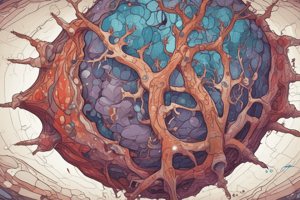Podcast
Questions and Answers
Which of the following is a common cause of cell injury?
Which of the following is a common cause of cell injury?
- Genetic abnormalities (correct)
- Increased cell size
- Cell duplication
- Tissue repair
What is the difference between reversible and irreversible cell injury?
What is the difference between reversible and irreversible cell injury?
- Reversible injury can be repaired, while irreversible injury cannot (correct)
- Reversible injury leads to apoptosis, while irreversible injury leads to necrosis
- Reversible injury is temporary, while irreversible injury is permanent
- Reversible injury is caused by genetic abnormalities, while irreversible injury is caused by oxygen deprivation
What happens when cells are exposed to inherently damaging agents?
What happens when cells are exposed to inherently damaging agents?
- Cells adapt and increase in size
- Cells undergo apoptosis
- Cells repair themselves
- Cells suffer irreversible injury (correct)
What is one of the patterns of cell death in tissues or organs?
What is one of the patterns of cell death in tissues or organs?
Which type of cell death is always accompanied by inflammation?
Which type of cell death is always accompanied by inflammation?
What is the characteristic feature of coagulative necrosis?
What is the characteristic feature of coagulative necrosis?
Which type of necrosis is typically seen in bacterial infections and brain infarctions?
Which type of necrosis is typically seen in bacterial infections and brain infarctions?
What is the specific form of coagulative necrosis that is typical of mycobacterial infections?
What is the specific form of coagulative necrosis that is typical of mycobacterial infections?
Which of the following is NOT a cause of hypoxia?
Which of the following is NOT a cause of hypoxia?
Which of the following physical agents can cause cell injury?
Which of the following physical agents can cause cell injury?
Which of the following chemicals can induce damage in cells?
Which of the following chemicals can induce damage in cells?
What is the major cause of cell injury?
What is the major cause of cell injury?
Which type of necrosis is characterized by the deposition of fibrin in arterial walls?
Which type of necrosis is characterized by the deposition of fibrin in arterial walls?
Which type of necrosis is typically seen in the lungs and is characterized by the formation of granuloma?
Which type of necrosis is typically seen in the lungs and is characterized by the formation of granuloma?
Which type of necrosis is secondary to ischemia and often involves the lower extremities?
Which type of necrosis is secondary to ischemia and often involves the lower extremities?
Which type of necrosis is characterized by enzymatic or traumatic damage to fatty tissue?
Which type of necrosis is characterized by enzymatic or traumatic damage to fatty tissue?
Which of the following is a characteristic of reversible cell injury?
Which of the following is a characteristic of reversible cell injury?
What is the main cause of fatty change in developed nations?
What is the main cause of fatty change in developed nations?
What is the main difference between reversible and irreversible cell injury?
What is the main difference between reversible and irreversible cell injury?
What type of cell death is associated with irreversible cell injury?
What type of cell death is associated with irreversible cell injury?
Which of the following is a consequence of ATP depletion in cells during an ischemic situation?
Which of the following is a consequence of ATP depletion in cells during an ischemic situation?
Which cellular component is affected by the failure of the calcium pump during ATP depletion?
Which cellular component is affected by the failure of the calcium pump during ATP depletion?
What is the main cause of the clumping of the nuclear chromatin during ATP depletion?
What is the main cause of the clumping of the nuclear chromatin during ATP depletion?
Which of the following is a consequence of mitochondrial damage during an ischemic situation?
Which of the following is a consequence of mitochondrial damage during an ischemic situation?
Which of the following is a consequence of an increase in Ca++ concentration inside the cell?
Which of the following is a consequence of an increase in Ca++ concentration inside the cell?
What is the main mechanism of cell death when Ca++ concentration increases inside the cell?
What is the main mechanism of cell death when Ca++ concentration increases inside the cell?
Which of the following is a characteristic of oxygen-derived free radicals?
Which of the following is a characteristic of oxygen-derived free radicals?
What are the protective molecules against oxygen-derived free radicals?
What are the protective molecules against oxygen-derived free radicals?
Which cells of the immune system are able to synthesize ROS to kill pathogens?
Which cells of the immune system are able to synthesize ROS to kill pathogens?
What are the consequences of the accumulation of oxygen-derived free radicals?
What are the consequences of the accumulation of oxygen-derived free radicals?
Flashcards are hidden until you start studying
Study Notes
Cell Injury and Death
- Inherently damaging agents, such as toxins, radiation, and extremes of temperature, can cause cell injury.
- Cell injury can be reversible or irreversible, with reversible injury characterized by cellular swelling and fatty change.
- Irreversible cell injury leads to cell death, which can occur through different patterns, including necrosis, apoptosis, and autophagy.
Types of Necrosis
- Coagulative necrosis is characterized by the formation of a coagulum, and is typically seen in the kidneys, liver, and heart.
- Caseous necrosis is a specific form of coagulative necrosis, typical of mycobacterial infections.
- Fibrinoid necrosis is characterized by the deposition of fibrin in arterial walls.
- Granulomatous necrosis is typically seen in the lungs and is characterized by the formation of granuloma.
- Fat necrosis is characterized by enzymatic or traumatic damage to fatty tissue.
- Gangrenous necrosis is secondary to ischemia and often involves the lower extremities.
Causes of Cell Injury
- Hypoxia is a common cause of cell injury, and can be caused by inadequate oxygen supply, ischemia, or anemia.
- Physical agents, such as radiation, extreme temperatures, and mechanical trauma, can cause cell injury.
- Chemical agents, such as toxins, drugs, and heavy metals, can induce damage in cells.
- Infections, such as bacterial and viral infections, can also cause cell injury.
Cell Death and Inflammation
- Necrosis is always accompanied by inflammation.
- Apoptosis is a type of cell death that is not accompanied by inflammation.
- The main cause of cell injury is hypoxia, which can lead to ATP depletion and mitochondrial damage.
ATP Depletion and Cellular Consequences
- ATP depletion can lead to the failure of the calcium pump, causing an increase in Ca++ concentration inside the cell.
- The clumping of nuclear chromatin is a consequence of ATP depletion.
- Mitochondrial damage during an ischemic situation can lead to the release of oxygen-derived free radicals.
- The accumulation of oxygen-derived free radicals can cause cellular damage and death.
Oxygen-Derived Free Radicals
- Oxygen-derived free radicals are highly reactive molecules that can cause cellular damage.
- Protective molecules, such as antioxidants, can defend against oxygen-derived free radicals.
- Certain cells of the immune system, such as neutrophils and macrophages, can synthesize ROS to kill pathogens.
- The accumulation of oxygen-derived free radicals can lead to cellular damage and death.
Studying That Suits You
Use AI to generate personalized quizzes and flashcards to suit your learning preferences.





